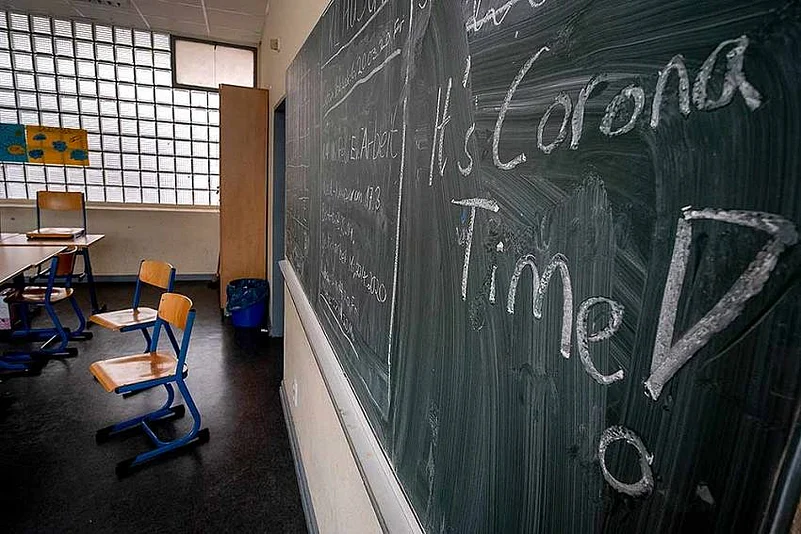When does home feel like a disaster zone? When schools are gone. This has been the most tragic lesson taught by 2020 to the poorest and most vulnerable children of India, for whom lost lessons have been the least of their tragedies. They have lost far more than a year of learning. They have lost much of life that will be hard to restore.
How does online school ironize this withering of the home space? Hear the story told by the principal of a civic school in Mumbai. While a student was attending online classes, a fight broke out between his parents and his father started beating his mother. The violence of home bled into his entire classroom. The shame was so deep that the student stopped classes and had to be counselled intensely to return to the online classroom after many days of absence.
Advertisement
And what did schools start to look like this year? A report in Mint tells the story of Kumari Swati Memorial school, a private primary school run by Bresh Pal Singh in Mujahidpur village in Uttar Pradesh. The school, which had 165 students before the pandemic, now look deserted, the teachers’ room filled with sacks of grains and fertilizers, the iron bell to chime in the classes covered with a layer of rust. The most heart-aching sight is that of a fading lesson of math scrawled on the green board.
Learning has faded. That has been the subject of much concern – a challenge faced even by the children of the relatively privileged. But what the nine months of the pandemic has taken away from the children of the poor and the vulnerable is far more – a real shelter, meals, affection, safety from violence and forced labour. Much of life itself.
Advertisement
In the cruellest of ways, the pandemic has brought home the fundamental importance of schools to the impoverished masses across India. Learning, one is forced to say, is the least of it.
Multiple reports and surveys have confirmed the failure of online school among the poor. A report on rural and impoverished schools by the Azim Premji Foundation has indicated that more than 80 per cent of the teachers have stated that it has been impossible to establish an emotional connection with students in the virtual mode. More than 90 per cent have indicated the difficulty of meaningful assessment of children’s learning. Almost 60 per cent of the children have been wholly unable to access online learning opportunities.
Findings from surveys conducted by Oxfam India tell us of the 27 crore children who have been affected by school closure in India, the impact on students in government schools has extended far beyond the loss of a site of learning. Midday Meals, textbooks, and other learning materials have been lost, though thankfully some governments have ordered the delivery of midday meals even during the lockdown. Such measures notwithstanding, over 80 per cent of parents reported the failure of education delivery during school closure. Eighty-five per cent of rural children were excluded from online learning opportunities as only 15 per cent of rural households have access to the internet. The proportion of exclusion is far higher among marginalized social groups such as Dalits, Adivasis, and Muslims.
Advertisement
Stories of exclusion have practically been directly proportionate to existing patterns of marginalization in society. According to a survey of 28,000 girls in Cambodia, India, Laos, Nepal, Sri Lanka, Tanzania and Vietnam by Bloomberg Room to Read, during the pandemic, one in two girls was at the risk of dropping out of education altogether. “When families can’t afford school and have to choose,” said John Wood, the founder of Room to Read, “they will often send boys.”
In India, this marginalization has also shown a clear geographic character. The severity of the challenges faced by students in remote parts of Jammu and Kashmir have moved past comparison with poor children in other parts of India. Some teachers in government schools in these areas have indicated that for them the closure of schools effectively began much earlier – to be precise, since the abrogation of Article 370 in August 2019. The viral video of the leaders of Tsürühu Students Union conducting an online exam for school-children in a dense forest in Nagaland tells a similar story of the digital divide. According to local sources reported in Nagaland Express, this was the one spot in Tsürühu village in Zunheboto district with adequate network connectivity.
Advertisement
What is lost for the nation’s poor when schools are lost? 2020 has left us with a tragic answer. While urban, middle-class India debates the pros and cons of online learning, the pandemic has shown us that for the poorest and the most vulnerable children of the nation, schools, howsoever dysfunctional, are the only available spaces to get some experience of childhood. With the disappearance of these spaces, these children face the inevitable fates that bring a swift end to childhood – most bitterly, the reality of child-marriage and child-labour. For these children, even learning can appear to be a luxury sometime, in a world where their fragmented schools offer the only glimpse into a phase of life that is snatched too early from them, sometimes fatally.
Advertisement
(With research input by Harshita Tripathi)
(Saikat Majumdar writes about arts, literature, and higher education. @_saikatmajumdar. Views are personal, and do not necessarily reflect those of Outlook Magazine.)




















